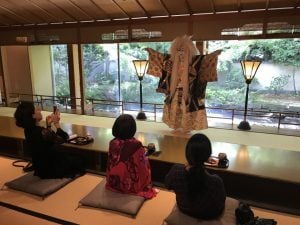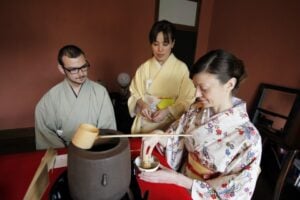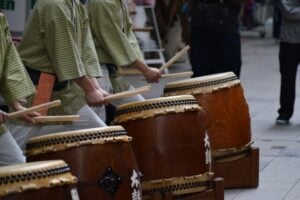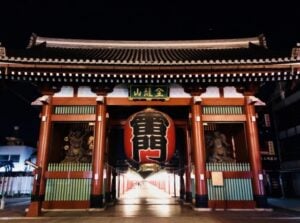
Are you worried about introducing Japanese culture to foreigners?
What skills do I need to introduce them and how can I best communicate this to them so they will understand?
In this article, we will explain Japanese culture based on a survey of popular Japanese culture among foreigners, and also introduce example sentences and vocabulary useful for communicating in English.
At the end, we will touch on Japanese culture that is recognized around the world, so please use this as a reference when introducing it to foreigners.
Let’s understand Japanese culture.

Before we can introduce them, we need to understand Japanese culture.
Japanese culture includes traditional arts such as Kabuki, Noh, flower arrangement and tea ceremony.
Japanese culture can also be considered to include food culture, religion, and other customs that have been taken for granted since ancient times. The following are examples of customary Japanese culture.
Food Culture
Religion
Construction
Transportation, etc.
While it is true that many foreigners are interested in these cultures, in many cases the Japanese culture as imagined by foreigners is probably the following.
Kabuki
Samurai
Tea ceremony
Wadaiko
This article will focus on traditional culture as Japanese culture.
Learn about popular Japanese culture

Motenas Japan conducted a survey of 500 foreigners about traditional Japanese culture they would like to experience.
Click here to read the article
From here, based on the questionnaire, we will explain what Japanese culture is popular among foreigners. Please use this as a reference for introducing Japanese culture to foreigners.
kabuki
The most popular Japanese culture among foreigners is Kabuki.
It is a well-known traditional culture with a history of 400 years. The word “kabuku” is derived from “kabuku,” meaning to dress or act strangely, and has long been popular as a culture that entertains people without being influenced by existing customs.
Even now, it is evolving in various ways while incorporating new trends. Cho-kabuki incorporating “Hatsune Miku” and the popular manga “One Piece” is also being staged, and is becoming more popular among foreigners.
The historical background and the flexibility to adopt new trends are two of the factors that make it interesting to foreigners. Kabuki is one of the Japanese cultural traditions favored by foreigners.
For more information about Kabuki, please also see this article.
Samurai, Killing, Ninja

One of the most famous aspects of Japanese culture is “samurai, sword fighting, and ninja. These are cultures that cannot be seen on a daily basis in today’s Japan, but are popular among foreigners.
One of the reasons for its worldwide popularity is probably the influence of films such as “The Last Samurai” and “Kill Bill.
In historical dramas, samurai in armor, striving to protect their lord, are seen as attractive by foreigners.
The killing techniques and ninja exploits shown in this context are cool and recognized around the world.
These can be experienced at the movie village, iaido classes, etc., so experiencing them during your stay will enhance your visit to Japan. Cultures that are no longer familiar to us are still very attractive and popular among foreigners.
See also this article for more details.
Tea ceremony, calligraphy, flower arrangement

Tea ceremony, calligraphy, and flower arrangement are also popular traditional cultures among foreigners.
The strong image of tea ceremonies in kimono makes them look like Japanese culture, and we can surmise that they are gaining in popularity. The image of tea ceremony in kimono is the very image of Japanese people.
In addition, calligraphy and flower arrangement can be enjoyed even to the point of appreciating the finished product, allowing students to experience Japanese customs and the spirit of taking good care of things.
All are traditional cultures that value spirituality and are still cherished by the Japanese people.
See also this article for more details.
Japanese drum

Japanese drumming is a popular traditional culture because of its dynamic performance experience, and was ranked 8th in a survey of 500 foreigners.
The rhythm is played with the full force of the body, and can be performed by one or more people. The more players, the more difficult it becomes to keep the rhythm together, but if you can play in unison, you will feel a sense of accomplishment.
There are also taiko classes and on-site experience services, so one way to introduce foreigners to taiko is to experience it with them. Motenas Japan can arrange the experience for you, so please feel free to contact us.
See also this article for more details.
Let’s communicate Japanese culture in English!

When communicating Japanese culture to foreigners, language is always a problem.
It would be nice if we could communicate smoothly in English, but the reality is that it is not always easy. Japanese people tend to try to communicate in English by carefully following grammar, but most of the time, if you can just keep the words in mind, you will be able to convey your message.
Don’t be distracted by difficult grammar; learn English vocabulary first, then learn simple sentences.
Useful English vocabulary and sentence examples
Here is an English translation of the names of the traditional cultures introduced earlier.
Kabuki・・・・kabuki
Samurai, Ninja・・・・samurai, ninja
Tea ceremony・・・・tea ceremony
Calligraphy
Kado・・・・flower arrangement
Japanese drum・・・・taiko, Japanese drum
Some Japanese words are translated directly into English, while others are said differently when translated into English. Kabuki and Samurai are still the same, but tea ceremony, calligraphy, flower arrangement, etc. are said differently.
It is a good idea to find out in advance how to read the English translation of the Japanese culture you wish to introduce.
In addition, when saying “00 is a traditional Japanese culture.
Here are some other English words that can be used to introduce traditional culture.
| famous about ○○ / famous in ○○ popular / popular experience / experience atmosphere / atmosphere cutting-edge / cutting-edge temple / temples all over the world / rarely / not often put on / worn put on |
Japanese Culture Recognized Worldwide

In addition to popular Japanese culture, there are other cultures that are recognized around the world. UNESCO Cultural Heritage includes both tangible and intangible cultural heritage. Tangible heritage includes Himeji Castle and Mt. Fuji, while intangible heritage includes traditional culture.
From here, we will explain the Japanese culture that has been registered as a UNESCO Intangible Cultural Heritage.
Japanese Cuisine
Nohgaku
Traditional food culture “Japanese food
UNESCO registered Japanese food in 2013. The spirit of respect for the ingredients that nature has blessed us with, the good nutritional balance based on one soup and one dish, and the close relationship between annual events and meals are the reasons for the registration.
In Japan, where nature is abundant, people have long eaten foods made from the bounty of nature. In addition to vegetables, other familiar foods such as tofu and natto (fermented soybeans) made from soybeans, and soba (buckwheat noodles) made by grinding and kneading the berries into flour are representative of this tradition.
Also, the culture of saying “Itadakimasu” before eating and “Gochisosama desu” when finished is also unique to Japan. From a foreigner’s point of view, this must be a strange sight.
Japanese food is a food culture that has been recognized by foreign countries. In order to cherish the culture, I would like to chew its goodness every day and spread it to the world.
Noh play
Nohgaku was registered as a “Representative List of the Intangible Cultural Heritage of Humanity” in 2008. Its history is longer than that of Kabuki, and it is a traditional culture that has continued for 600 years.
Its mysterious performances and performances have an appeal that draws people in, making it a popular traditional culture among foreigners.
There are various types of Noh, including those in which the audience enjoys the development of the story, those in which there are fierce battles, those in which powerful demons appear, and those in which women dance in a quiet manner.
What all of these have in common is that they deal with “universal human feelings. One of the charms of Noh drama is that you can feel the deep drama of human beings.
It is a traditional culture that was able to develop because the Japanese value spirituality, and I am sure that foreigners will also enjoy it once they understand it.
Summary

In this article, we have discussed introducing Japanese culture to foreigners.
Among the various types of Japanese culture, we hope you were able to learn about the culture that is popular among foreigners.
If you are a foreigner who would like to experience Japanese culture, please contact Motenas Japan. We have supported numerous experiences for foreigners and can make proposals that meet your needs. We are always available for consultation.
Our hope is that people will learn about Japanese culture and come to love Japan more.

30s male writer. He has worked in a hotel for 16 years and is involved in the travel industry. Through his work at travel agencies and hotels, he developed an interest in travel and often goes on trips. His favorite cities are Sendai and Hakata. He conveys the knowledge he has gained through his travels and the charms of Japan with care.





